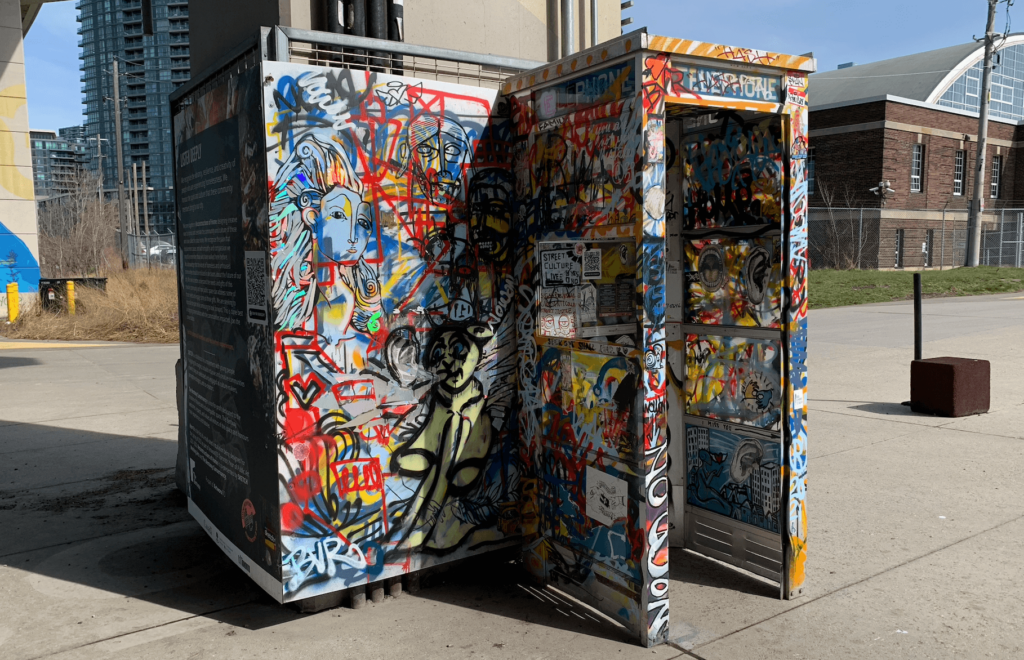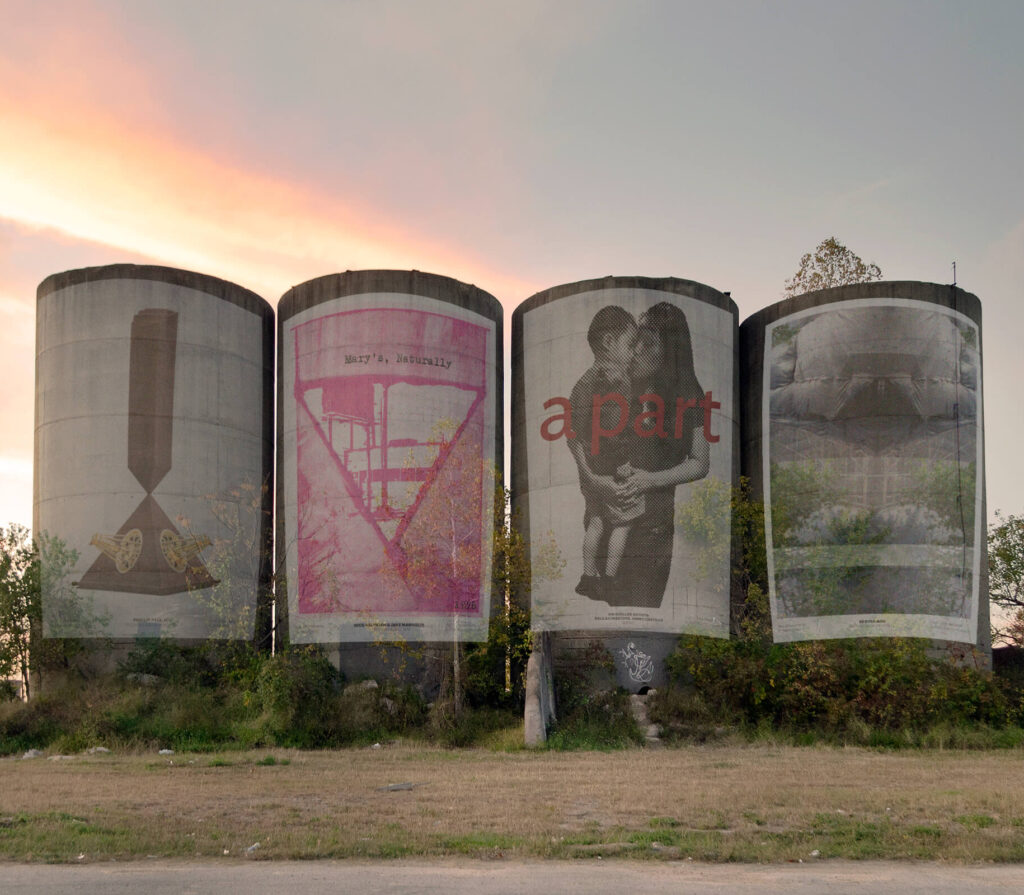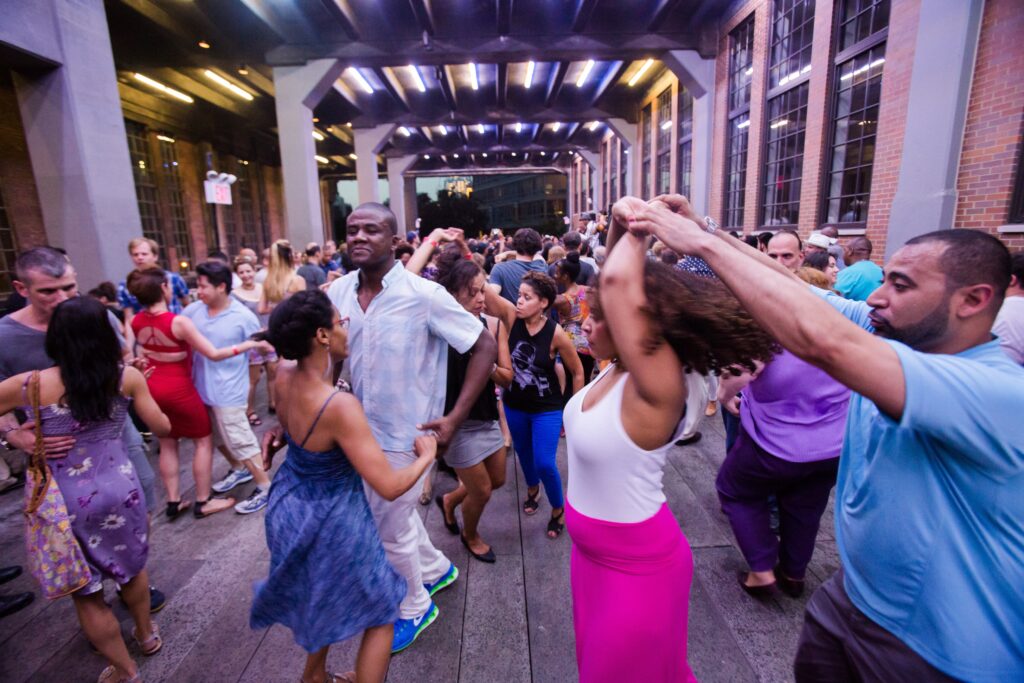Would you like to showcase your own work to embed equity in your infrastructure reuse project?
All-Season Support: Staff, Small Scale Infrastructures, and Intentional Partnerships

Hear US – an installation sharing the stories of those who’ve experienced houselessness – presented at The Bentway in collaboration with SKETCH Working Arts. Credit: Allie Fenwick
More than a destination, The Bentway is a new type of civic organization and public space in Toronto’s growing downtown west neighborhood, beneath the city’s major active downtown highway, the Gardiner Expressway. Phase 1 of the park opened in 2018, knitting together seven neighborhoods, linking nearly 100,000 residents, and serving as a gateway to the waterfront and local attractions.
The Bentway was designed as an open and accessible space that eschews defensive or hostile architectural practices. It functions much like a public library, a model of social infrastructure that requires thoughtful dialogue and ongoing staff training and protocols to better support a myriad of visitors. Welcoming staff, programs targeted towards those most in need, and collaborative partnerships contribute to The Bentway’s role in the city. It also fulfills its mission to ignite the urban imagination, using the city as site, subject, and canvas.
While the hybridized use of the Toronto Gardiner Expressway followed significant municipal projects, such as once-in-a-generation rehabilitation to the highway’s structure, it did not directly result in displacement of individuals experiencing homelessness. However, The Bentway recognized the trajectory of construction beneath the Gardiner Expressway would likely have effects on those seeking shelter within the public realm. In order to address this, The Bentway decided to designate funds within their annual operating budget to develop programs (in collaboration with local shelters and respite centers), purchase and distribute small scale supports (such as hats, gloves, bike tubes), and train personnel to support the community’s most vulnerable groups—including downtown Toronto’s homeless population. For instance, during design development, The Bentway planned for wifi, restrooms, and power throughout the park and quickly observed that these resources, beyond supporting Bentway-delivered programs, were also beneficial to visitors’ daily park experience. This prompted The Bentway to invest in additional small-scale infrastructures throughout the park including lockers, more restrooms, and warming huts. Whether on or off The Bentway, many Torontonians rely on the park infrastructure to support their daily needs.
Further, The Bentway matches donations collected on-site to support their annual winter community care kit initiative. Now in its third––and biggest––year, this program creates and distributes winter essentials to local respite centers and shelters.
The Bentway’s onsite team plays a major role in supporting visitors too, often acting as the organization’s lead agents in creating a welcoming, kind atmosphere for all. Staff have personal relationships with park users, including users who are unhoused, and observed that daily use patterns at The Bentway closely aligned with the cleaning schedules at local respite centers. This led The Bentway to initiate communication and partnership with local social service providers—such as shelters and respite centers—to contribute to a collective effort to aid at-risk neighbors. The clear devotion of time, money, and personnel aligns with the park’s larger vision as an inclusive and accessible public space that is responsive to and reflective of the diverse communities it serves.
Programming is a large part of The Bentway’s neighborhood-based approach to supporting vulnerable communities, and serves as a forum for community consultation and engagement. One program, Reconstructions of Home ––A Wandering, was a multimedia outdoor walking tour of art installations and soundscapes organized by SKETCH, a local arts organization for at-risk youth. The mission of the exhibition, through digital and physical interventions, was to celebrate the creativity of unhoused communities in Toronto and end stigmas regarding homelessness. SKETCH worked with vulnerable individuals (with lived experience in houselessness) to record and archive oral histories and produce a series of art installations. The project helped vulnerable populations better see themselves at The Bentway and made visible the contributions and histories of those experiencing homelessness to the wider public. In 2023, The Bentway will continue its programming efforts and host weekly creative writing workshops for residents of the local respite center.
By committing funds and developing strategic partnerships, The Bentway is actively supporting and amplifying public awareness of these vulnerable groups and their needs. Alongside the City of Toronto, The Bentway is working to ensure that unhoused populations are being consulted and represented throughout all stages of The Bentway’s development. Since these commitments require external and internal engagement strategies, an internal working group at The Bentway also meets regularly to discuss how all departments can align messaging, services, and engagements to better support the target communities identified by the organization. This includes educating a broad park visitorship and remaining transparent about the many ways The Bentway includes, represents, listens to, and supports Toronto’s vulnerable communities.
More than a destination, The Bentway is a new type of civic organization and public space in Toronto’s growing downtown west neighborhood, beneath the city’s major active downtown highway, the Gardiner Expressway. Phase 1 of the park opened in 2018, knitting together seven neighborhoods, linking nearly 100,000 residents, and serving as a gateway to the waterfront and local attractions.
The Bentway was designed as an open and accessible space that eschews defensive or hostile architectural practices. It functions much like a public library, a model of social infrastructure that requires thoughtful dialogue and ongoing staff training and protocols to better support a myriad of visitors. Welcoming staff, programs targeted towards those most in need, and collaborative partnerships contribute to The Bentway’s role in the city. It also fulfills its mission to ignite the urban imagination, using the city as site, subject, and canvas.
While the hybridized use of the Toronto Gardiner Expressway followed significant municipal projects, such as once-in-a-generation rehabilitation to the highway’s structure, it did not directly result in displacement of individuals experiencing homelessness. However, The Bentway recognized the trajectory of construction beneath the Gardiner Expressway would likely have effects on those seeking shelter within the public realm. In order to address this, The Bentway decided to designate funds within their annual operating budget to develop programs (in collaboration with local shelters and respite centers), purchase and distribute small scale supports (such as hats, gloves, bike tubes), and train personnel to support the community’s most vulnerable groups—including downtown Toronto’s homeless population. For instance, during design development, The Bentway planned for wifi, restrooms, and power throughout the park and quickly observed that these resources, beyond supporting Bentway-delivered programs, were also beneficial to visitors’ daily park experience. This prompted The Bentway to invest in additional small-scale infrastructures throughout the park including lockers, more restrooms, and warming huts. Whether on or off The Bentway, many Torontonians rely on the park infrastructure to support their daily needs.
Further, The Bentway matches donations collected on-site to support their annual winter community care kit initiative. Now in its third––and biggest––year, this program creates and distributes winter essentials to local respite centers and shelters.
The Bentway’s onsite team plays a major role in supporting visitors too, often acting as the organization’s lead agents in creating a welcoming, kind atmosphere for all. Staff have personal relationships with park users, including users who are unhoused, and observed that daily use patterns at The Bentway closely aligned with the cleaning schedules at local respite centers. This led The Bentway to initiate communication and partnership with local social service providers—such as shelters and respite centers—to contribute to a collective effort to aid at-risk neighbors. The clear devotion of time, money, and personnel aligns with the park’s larger vision as an inclusive and accessible public space that is responsive to and reflective of the diverse communities it serves.
Programming is a large part of The Bentway’s neighborhood-based approach to supporting vulnerable communities, and serves as a forum for community consultation and engagement. One program, Reconstructions of Home ––A Wandering, was a multimedia outdoor walking tour of art installations and soundscapes organized by SKETCH, a local arts organization for at-risk youth. The mission of the exhibition, through digital and physical interventions, was to celebrate the creativity of unhoused communities in Toronto and end stigmas regarding homelessness. SKETCH worked with vulnerable individuals (with lived experience in houselessness) to record and archive oral histories and produce a series of art installations. The project helped vulnerable populations better see themselves at The Bentway and made visible the contributions and histories of those experiencing homelessness to the wider public. In 2023, The Bentway will continue its programming efforts and host weekly creative writing workshops for residents of the local respite center.
By committing funds and developing strategic partnerships, The Bentway is actively supporting and amplifying public awareness of these vulnerable groups and their needs. Alongside the City of Toronto, The Bentway is working to ensure that unhoused populations are being consulted and represented throughout all stages of The Bentway’s development. Since these commitments require external and internal engagement strategies, an internal working group at The Bentway also meets regularly to discuss how all departments can align messaging, services, and engagements to better support the target communities identified by the organization. This includes educating a broad park visitorship and remaining transparent about the many ways The Bentway includes, represents, listens to, and supports Toronto’s vulnerable communities.
Share this Case Study


